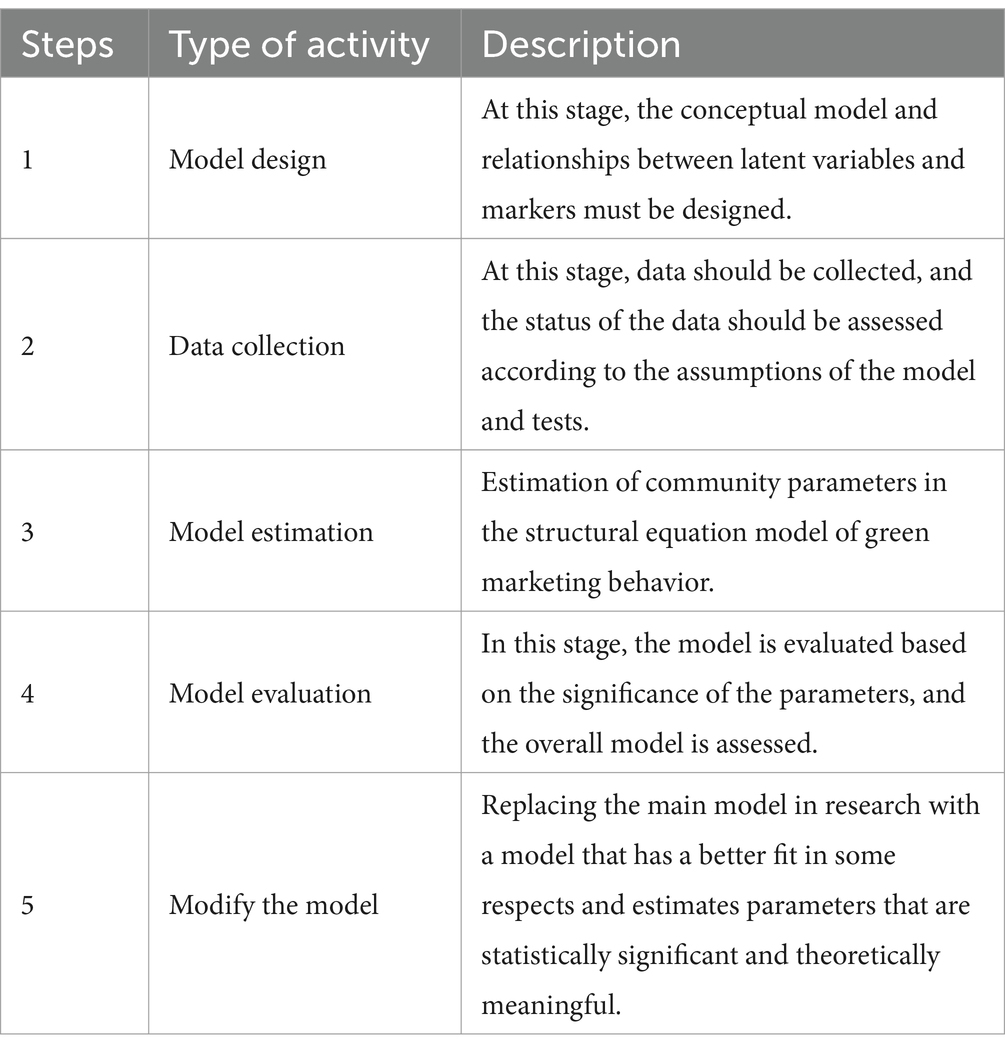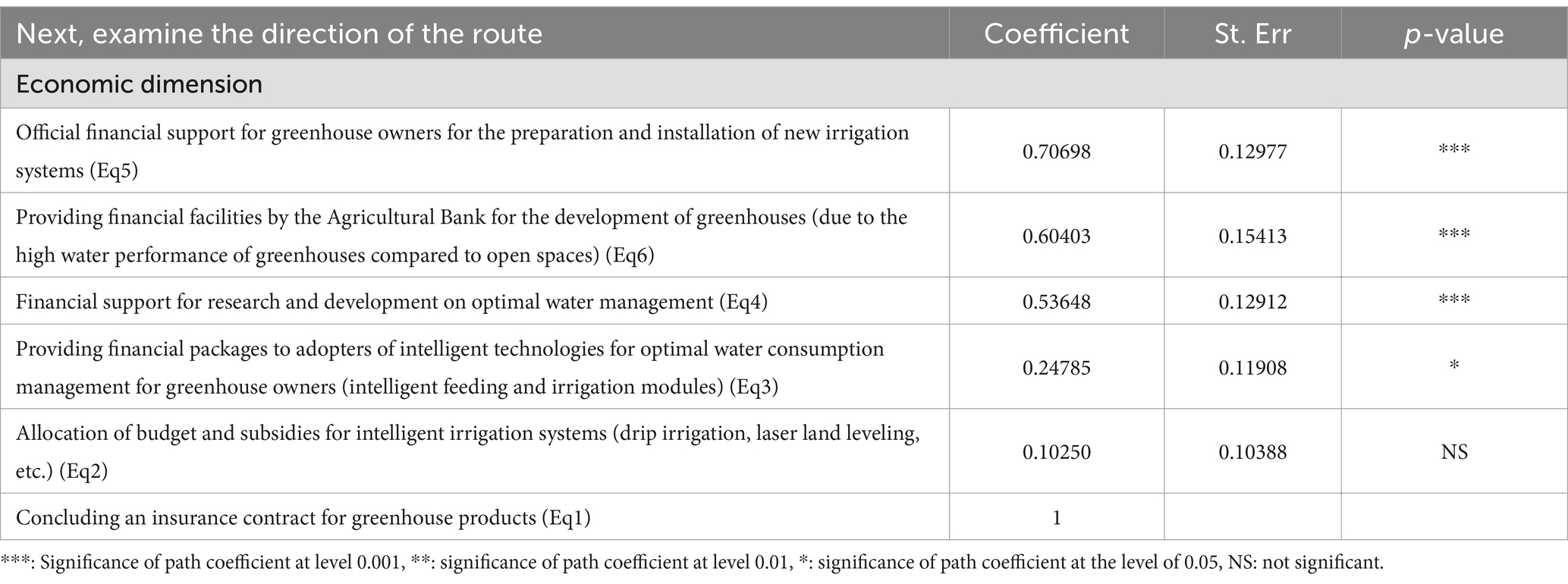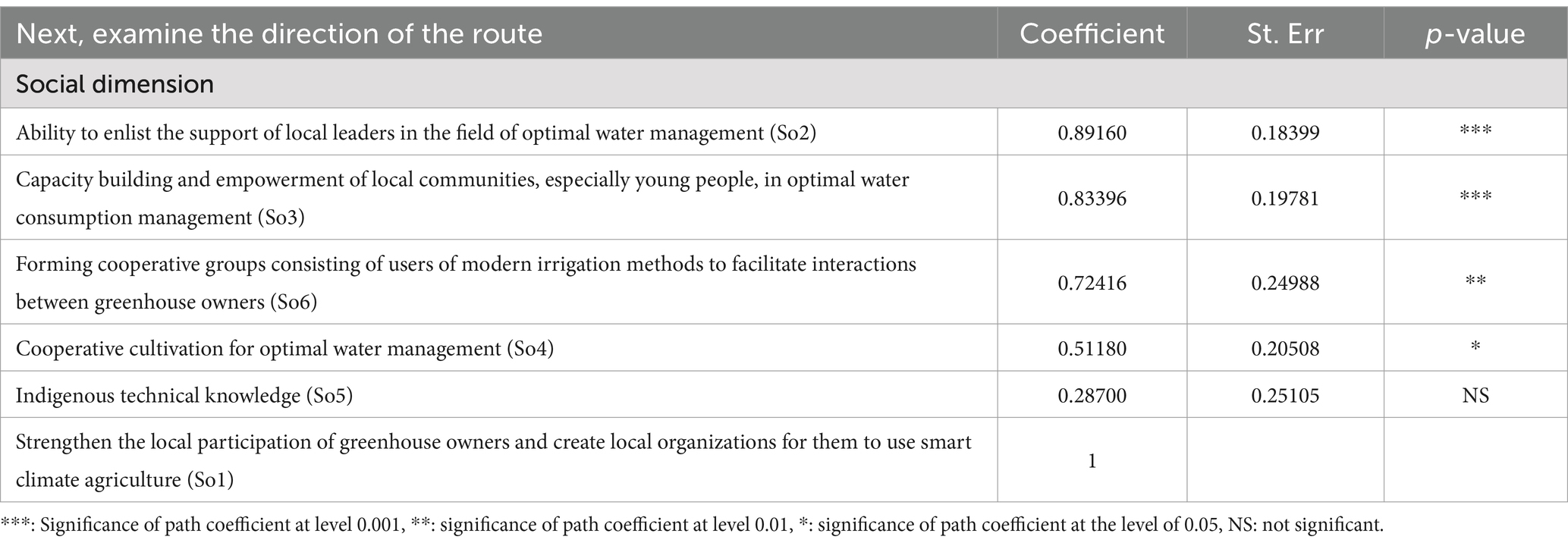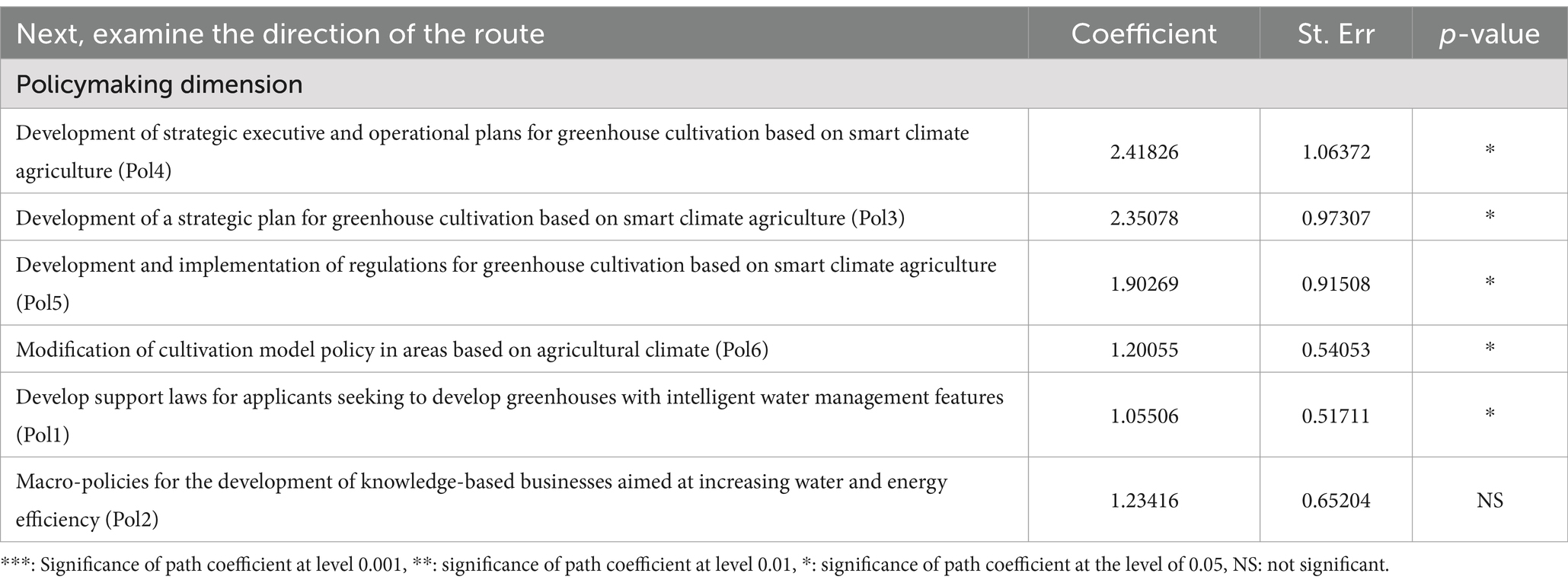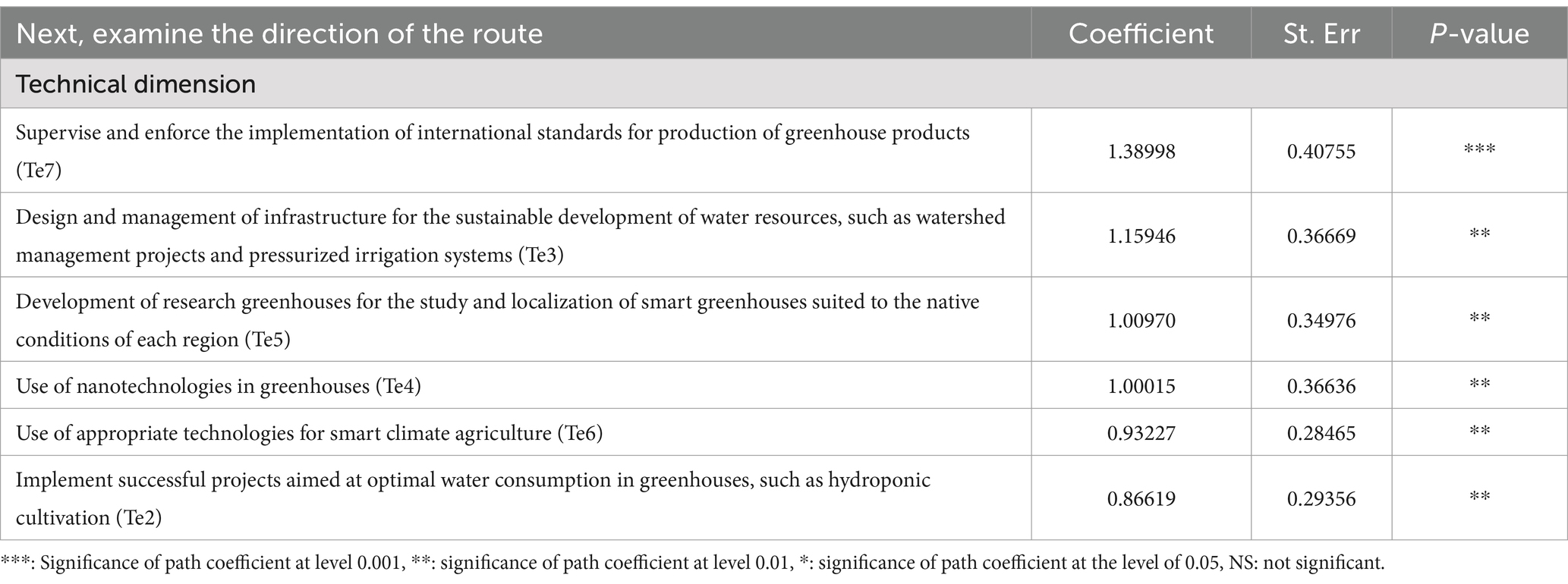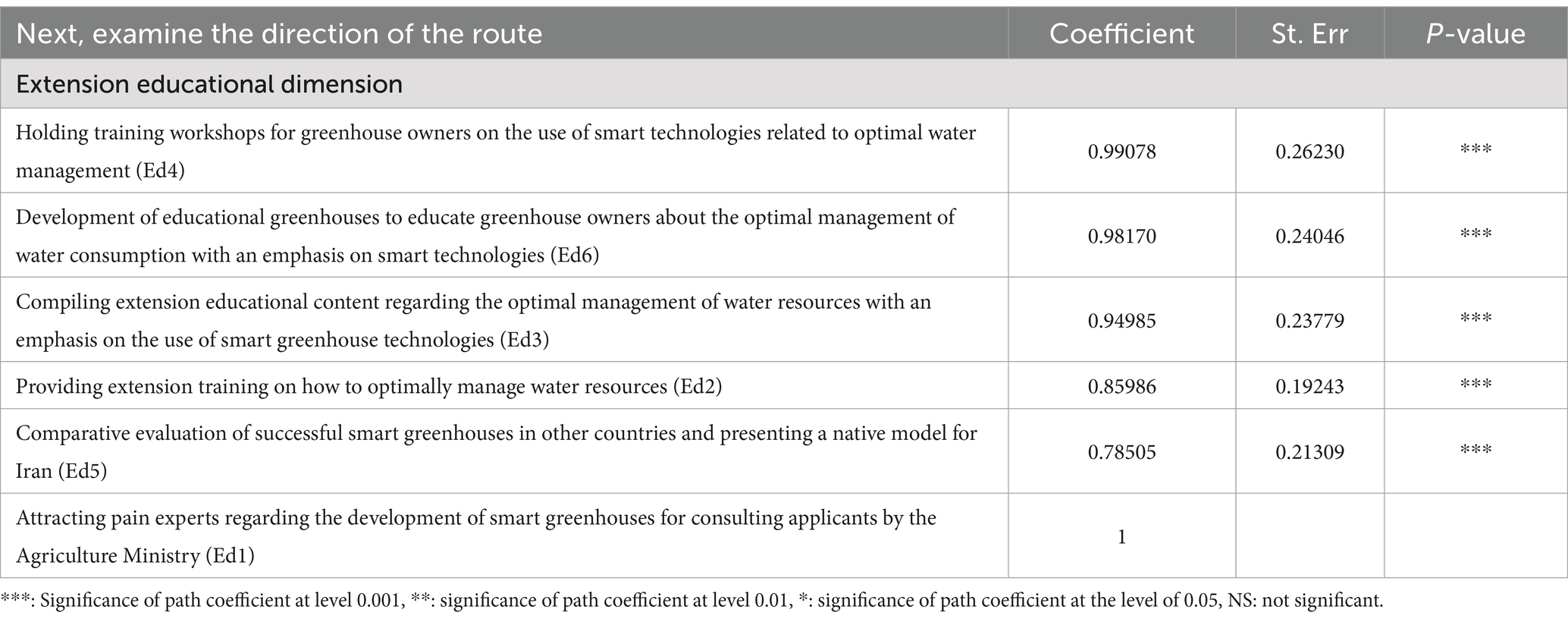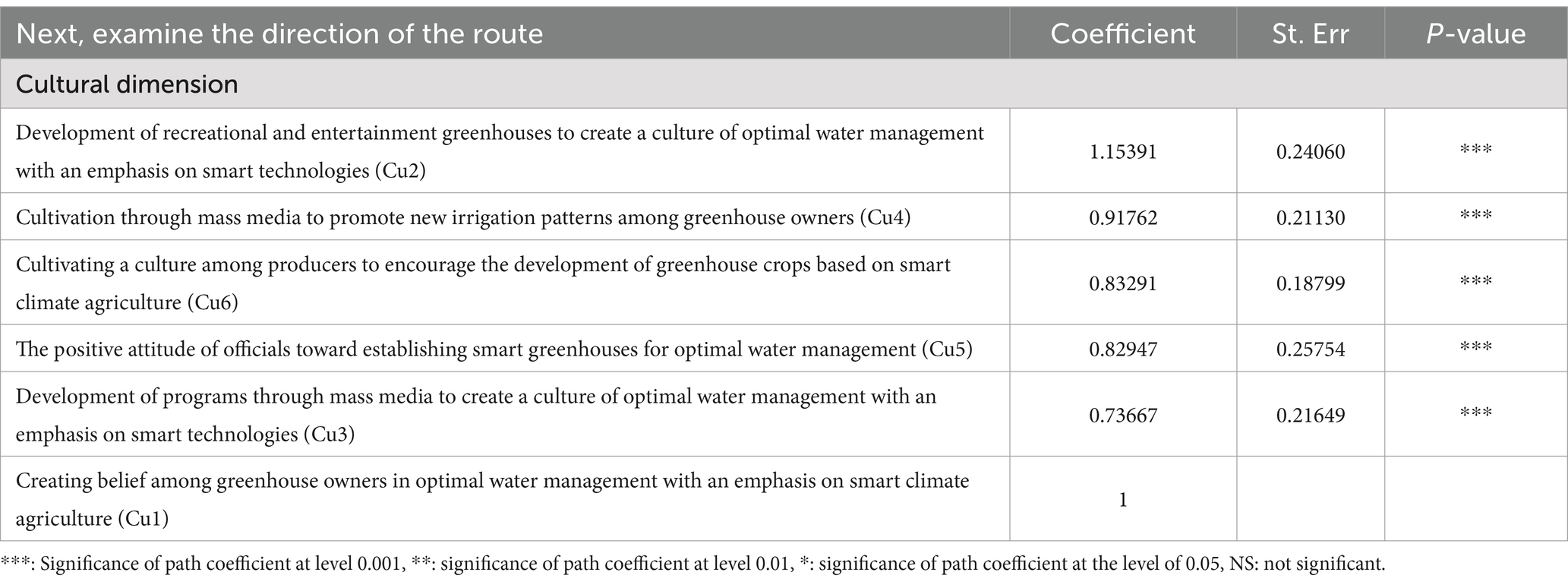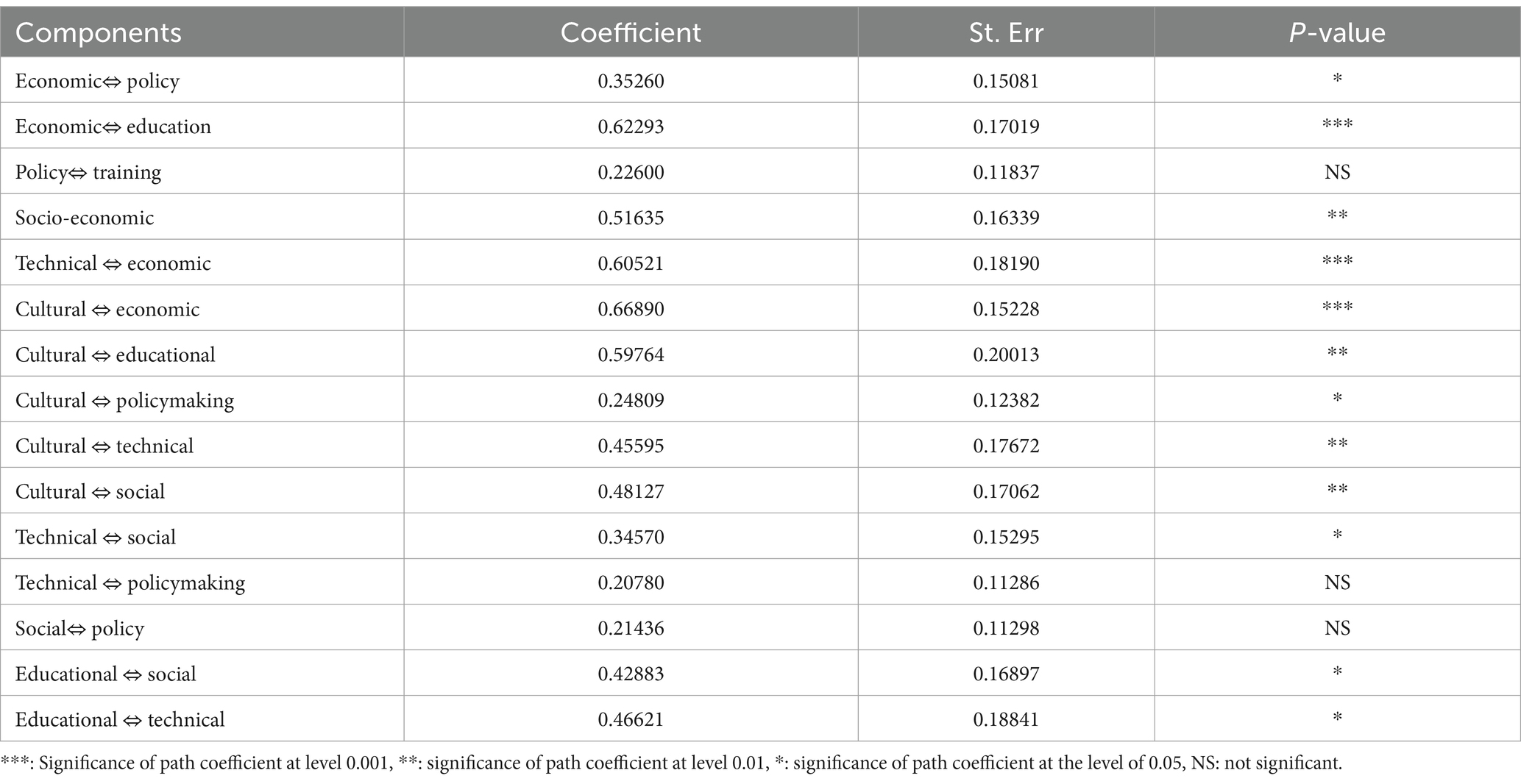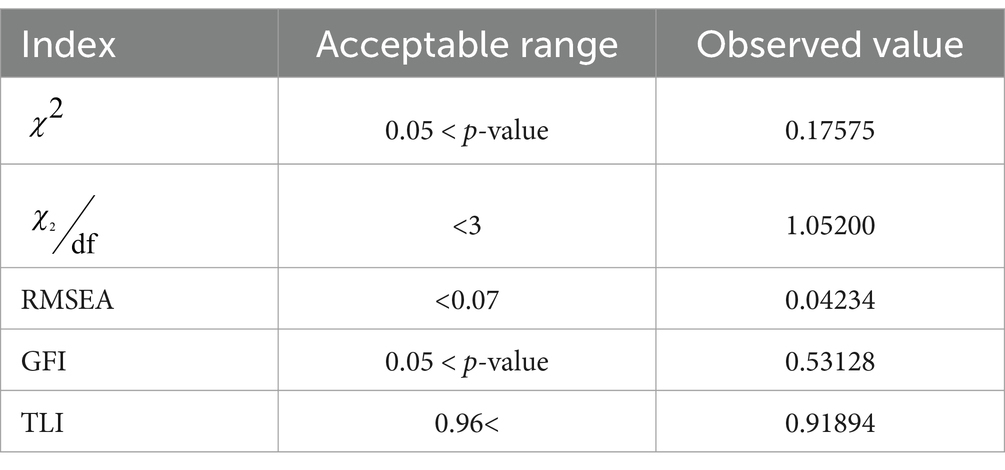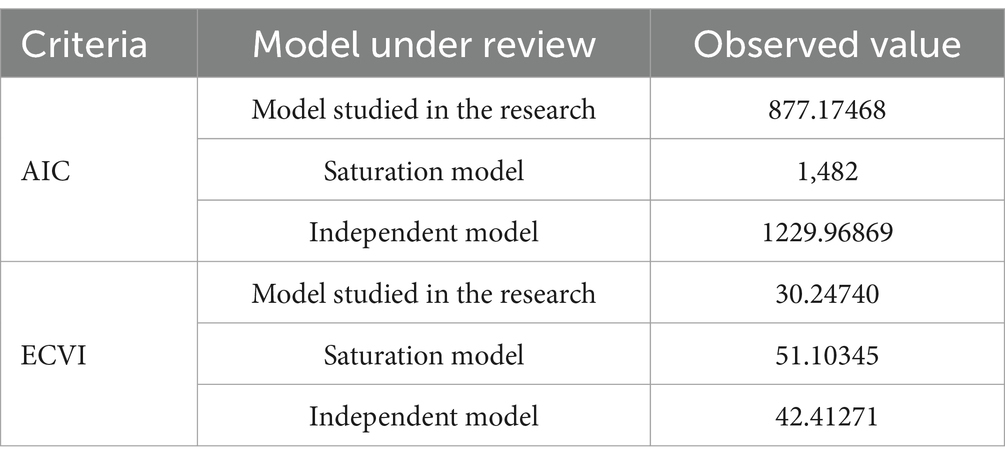- 1Department of Agricultural Economics, Extension and Education, SR. C., Islamic Azad University, Tehran, Iran
- 2Department of Agricultural Extension and Education, Ga. C., Islamic Azad University, Garmsar, Iran
Considering that the behavior of farmers regarding the use of smart climate agricultural technologies is influenced by the socio-economic conditions of their locality, this study identified the constituent components of optimal agricultural water consumption management in Pakdasht city, Iran. To analyze the data, structural equation modeling (SEM) was employed using AMOS20 to investigate the linear relationships between latent and explicit variables. The results showed that the hidden variables of educational and economic, technical and economic, and cultural and economic dimensions have a significant relationship with each other. Variables such as financial support from official institutions to greenhouse owners for the preparation and installation of new irrigation systems, financial facilities provided by Agriculture Bank for greenhouse development, financial support for research and development in optimal water management, and financial support packages for adopters of smart technologies impact the economic dimension of water consumption management among greenhouse owners. Additionally, the ability to attract support from local leaders for optimal water management, capacity building, and the empowerment of local communities—particularly youth—in this area, as well as the formation of cooperative groups among users of new irrigation methods, facilitate interactions between greenhouse owners.
1 Introduction
Today, climate change is one of the most significant environmental challenges of the 21st century, with various consequences. Agriculture is one of the sectors most affected by climate change. Studies have shown that communities are responding to these impacts by regulating economic activities, improving resource management, changing land use practices, and altering infrastructure design and implementation (Adger et al., 2011). The set of these responses is called adaptation. Adaptation to climate change may be spontaneous or the result of management processes (Dehghanpour et al., 2020). The World Food Program has introduced a model called smart climate agriculture as a resilient and productive agricultural system for better resource management in the face of climate change. The model envisions three principles: building resilience and adaptation to climate change, sustainably increasing productivity and income in the agricultural sector, and reducing or eliminating greenhouse gas emissions where possible (Jomegi et al., 2024). Currently, optimal management of agricultural water consumption through modern irrigation systems is considered a smart climate agriculture strategy. However, the use of such systems, while saving water, has created challenges related to increased energy consumption and greenhouse gas emissions. Although some recent studies have provided valuable analyses of the relationship between water and energy in agricultural irrigation systems, smart climate agriculture necessitates simultaneous attention to productivity, adaptation, and reduction of environmental impacts in optimizing the cropping pattern of an agricultural system, which has been less addressed.
Drought and water scarcity in Iran are climatic realities, and due to the growing need for water in various sectors (drinking, industrial, agriculture, energy production, etc.), this problem will become more acute in the coming years. The impact of climate change on agricultural production and the livelihoods of rural households in Tehran province has been significant. While the average annual rainfall in this province is 70 percent lower than the global average, more than 151 million cubic meters per year have been over-extracted from groundwater resources in Tehran province during recent droughts. Reports from the National Drought Monitoring and Warning Center also show that about 42.3 percent of the area of this province is affected by moderate drought, and 35.6 percent is affected by severe drought, with only 0.9 percent of the total area of Tehran Province experiencing wet conditions (Dargahi Maraghe et al., 2025).
Therefore, enhancing farmers’ resilience to current and future droughts is imperative. Implementing smart climate agriculture practices can help (Khakifirouz et al., 2022). In such cases, optimal use and savings in water consumption are among the effective and practical solutions (Arbués et al., 2016). Meanwhile, managing water consumption in the agricultural sector, which accounts for a significant part of water use in Iran and the world, can be highly effective and path-breaking. Achieving this requires identifying the main indicators of water consumption management and determining these indicators through appropriate methods. In this regard, improving irrigation efficiency and water use efficiency in agriculture, reducing the amount of water used in the agricultural sector, and promoting the sustainable development of new irrigation methods are among the most important aspects that should be included in macro planning related to supply, allocation, and principled consumption (Beddington et al., 2012; Niknami et al., 2014).
Several studies have examined the relationships between the management of agricultural water consumption optimization constructs based on smart climate agriculture.
Li et al. (2025) showed that under optimized water (196–157–123 mm) and nitrogen (207–236-84 kg/ha) conditions, water and carbon footprints decreased by 2.25–5.46% and 3.37–13.82%, respectively, compared to local practices. Economic benefits and overall quality improved by 8.27–21.06% and 4.06–7.63%, respectively. Han et al. (2024) emphasized the necessity of implementing an all-encompassing water management strategy that incorporates the ecological, financial, and societal dimensions as essential constituents of effective water utilization. Zhang et al. (2024) stated that the sustainability of the water industry management model is crucial for achieving sustainable utilization of water resources. This study found that the overall competitiveness indicator in the sustainable water industry management model and the sub-dimensional competitiveness indicators in resource support, development base, and environmental impact of the water industry of France are superior to those in China. Conversely, China is more competitive in social inclusion, technological innovation, and sustainability of the water industry. Omotayo and Omotoso (2025) noted that adopting smart climate agricultural technology enhances water availability, crop yield, food nutrition, and water security. Therefore, policies focused on investing in capacity-building initiatives to enhance farmers’ knowledge and skills in smart climate agricultural technology adoption and water resource management, particularly targeting marginalized communities and women farmers, would contribute to the increased implementation of smart climate agricultural technology, thus resulting in improved food nutrition and water security in South Africa. Li et al. (2024) found that smart climate irrigation strategies adapted to diverse climatic conditions largely mitigate agricultural water consumption while maximizing crop productivity and water use efficiency, which are essential for achieving precision irrigation and sustainable water management under a changing climate. Mabhaudhi et al. (2025) highlighted that distinct linkages exist between Weather and Climate Information Services (WCIS) and various Climate Smart Agriculture (CSA) categories. The study argues that increasing access to WCIS can facilitate the adoption and scaling of CSA practices. Adimassu et al. (2025) indicated that various CSA practices enhanced soil organic matter and carbon stocks. Water management practices, especially drip and deficit irrigation, demonstrated significantly higher water productivity than traditional flood irrigation, with an effect size of up to 2.6. This water use efficiency suggests that these methods could free up substantial water resources for irrigating additional land, thus boosting crop production in water-scarce areas. However, the analysis revealed a negative effect size of up to −0.74 for income derived from drip irrigation, primarily due to the high costs of the necessary equipment. This highlights the need for reforms in duty and tax exemptions to improve farmers’ profitability from drip irrigation systems. Overall, this meta-analysis assesses the impact of various CSA practices on key performance indicators, productivity, adaptation, and mitigation, providing insights that can guide the packaging and implementation of the most effective CSA strategies across Ethiopia’s agroecological zones. Various empirical studies have measured the economic effects of climate change on agriculture. One of the effective parameters on the consumption pattern and management of water demand is pricing and determining appropriate water tariffs. In Iran, the current state of the water pricing system is primarily influenced by socio-political considerations, while financial and economic performance is less important (Arslan et al., 2015). How to manage water is an issue that has been considered as fundamental to all climate change adaptation strategies (Campbell et al., 2014). This is especially true in rural areas and agriculture, where water plays a vital role in crop and livestock production as well as ecosystem management (forests, pastures, and agricultural lands). In addition, there is a role for water resource management in climate control measures (Berrang-Ford et al., 2021). The first effect of climate change on water in agriculture is due to increased rainfall fluctuations, rising temperatures, and extreme events (such as droughts and floods). Climate change generally affects water resources in the long term and reduces their reliability, especially in areas of the world that are already facing water scarcity. Climate change is expected to increase the pressure on currently pressurized systems. Smart climate agriculture has been proposed as a strategy to increase food productivity, build resilience to climate change, and reduce carbon emissions. Despite technical advances, research on smart climate agriculture has neglected social and political processes, which continue to exert pressure on vulnerable groups such as smallholder farmers (Chandra et al., 2017). Tavassoti et al. (2021) found the results of the structural equation modeling approach indicated the effect of abstract norms on behavioral intention and the effect of this variable on the behavior of optimal management of agricultural water consumption in Pakdasht city. An examination of the results of the research conducted indicates that each study focused on a specific dimension of the components of optimal agricultural water use management, while this study analyzed the relationships of all dimensions based on the climate smart agriculture approach. Accordingly, the aim of the present study was to analyze the interrelationships of the components of optimal agricultural water use management based on smart climate agriculture.
2 Methods
The study area is Pakdasht County, one of the counties in Tehran Province. This county is located south of Tehran, with its center in Pakdasht city. According to the 2016 Census of the Statistical Center of Iran, there are 103,542 households and 410,609 residents in this county. The area of this county is 610 square kilometers, situated at an altitude of 1,013 meters above sea level. It has two central districts, Sharifabad, three cities—Pakdasht, Sharifabad, Faroonabad—and six rural districts: Filistan, Faroonabad, Hesar Amir, Jamalabad, Sharifabad, and Karimabad. Agriculture in this county is thriving, leading to its reputation as the capital of flowers and plants in Iran due to the extensive cultivation of vegetables, flowers, and ornamental plants. Irrigation of agricultural lands is accomplished through deep and semi-deep wells and the Jajrud River.
The present study is cross-sectional regarding its applied purpose, the control of non-experimental variables, and the survey method used for data collection. The statistical population of this study comprises greenhouse owners in Pakdasht County, totaling 322 individuals. The sample size was determined using the Cochran formula, resulting in 51 participants. Individuals were selected through simple random sampling using a random number table. The field study was conducted via face-to-face interviews. Data collection occurred in two stages, namely, a library study and review of the research background through database searches and the field stage. In the field stage, a questionnaire was used as the primary research tool based on the five-level Likert scale. The prepared questionnaire was reviewed by several experts, and necessary amendments were made based on their feedback. Consequently, the face and content validity of the questionnaire was confirmed. Next, a pre-test study was conducted outside the study area. The response rate to the questionnaire was 93%. Finally, the collected data were analyzed after coding using SPSS and AMOS software with the structural equation model (SEM). Structural equation modeling is a communication model that illustrates the relationships among a set of studied variables. Researchers typically discuss structural equation models using images called path diagrams. In general, structural equation modeling uses various modeling methods to achieve a definitive model and configure the factors affecting the selection of research and statistical methods by established standards. Therefore, to combine causal information with statistical data and provide a quantitative assessment of the relationships between the study variables, a structural equation model is proposed. This method is used to simultaneously test the relationships between independent and multiple dependent variables and estimate the model parameters while calculating the error size of latent variables. In this study, it is applied to evaluate the communication network between hidden and explicit variables (Teklewold et al., 2017).
The first step in structural equation modeling is to conceptualize the model, which involves hidden variables and uses theoretically based cognitive mapping and hypotheses (as a guide) to link latent variables to each other. Input and output variables are identified. Hidden variables in the structural equation model are derived from the causal results of the map analysis and through path analysis. The second step is to structure the measurement model. This involves creating a path diagram that presents real assumptions and measurement schemes, according to a measurement model that includes observed indices used as measurement tools for latent variables. Before testing the hypotheses of relationships between latent variables, the validity of the measurement model must be established. If not, the model must be modified to ensure all indicators can confirm the latent variable. The researcher can evaluate a reliable measurement model in two ways: first, by testing the latent variable separately, and second, by testing all the measures together. In addition, the identification of explicit variables occurs in two steps: in the first step, a set of indicators is used to measure a latent variable, and in the second step, the reliability and validity of these measurements are assessed. In the third step, model fit evaluation is performed. For this purpose, the validity of the initial parameters is calculated, and then, using software, an implicit covariance matrix appropriate to the observations is obtained. In addition, significance tests are conducted to determine that the obtained parameters are significantly different from zero. When the implicit covariance matrix equals the covariance matrix of the observed data as determined by the model, the model is considered appropriate. The general steps in structural equation modeling analysis are outlined in Table 1.
2.1 Fitness indicators
Model fit refers to how well the model represents the original theory with the data in question. However, there is no complete consensus on this fit. Despite the abundance of available indicators, many differences exist among researchers in this field. Therefore, the most important stage of evaluation in structural equation modeling is determining whether a specific model fits the data. For this purpose, design indicators are created and classified into different types, mainly divided into absolute, relative, and adjusted indicators. Absolute indicators address how well the proposed theory aligns with the data. These indices measure the model to assess if the unexplained variance is significant after fitting the model. Model fitting is done without comparison to another model. These indicators include RMSEA, GFI, AGFI, RMR, SRMR, and χ2. Relative indicators aim to answer how well a model performs compared to other possible models in explaining a set of observed data. These indicators include NFI, IFI, DELTA2, TLI, and CFI. Modified indicators address how the model combines fit and economy or brevity, which includes PGFI and PNFI.
3 Results
Preliminary results show that most people are in the age range of 41–50, with only 9.804% of respondents under 20 or over 60 years old. The level of education of individuals is another piece of information questioned in the questionnaire. As it turns out, most respondents have an undergraduate degree (56.86%), while only 1.96% hold a bachelor’s degree (master’s and doctorate). Another important factor in compiling the questionnaire was the number of years of work experience. In the first part of this questionnaire, the factors affecting the economic, social, technical, policymaking, extension educational, and cultural dimensions (of which the six hidden variables of this part of the research are qualitatively discrete and measured by a sequential scale, the Likert scale) are examined. For this purpose, we consider 38 explicit variables (indicators) in the form of 6 hidden variables (factors). It should be noted that in these calculations, for each hidden variable, we have considered one of the path parameters as a fixed number of 1. This parameter is related to the path that (a) has the largest share in measuring the hidden variable and (b) is equal to the hidden variable. Therefore, considering this parameter as a constant, it is clear that there is no standard deviation and p-value for this case. In the following, we first introduce the effect of hidden variables on the explicit variable related to its category and then examine the relationships in general.
3.1 Economic dimension
In this section, the economic dimension with a constant coefficient of 1 is assigned to the variable “Concluding an insurance contract for greenhouse products.” According to the results of the SEM analysis, the variable “budget allocation and subsidies for intelligent irrigation systems “has no effect on the economic dimension and can be ignored. The variables that significantly affect the economic dimension at the significance level of 0.001 are 1. Financial support of official institutions to greenhouse owners for the preparation and installation of new irrigation systems (0.70698). 2. Providing financial facilities by the Agricultural Bank for the development of greenhouses (0.60403). 3. Financial support for research and development on optimal water management (0.53648). The variable “Providing financial support packages to the adopters of intelligent technologies for optimal water consumption management for greenhouse owners (0.24785)” will also be effective at the level of 0.05. Table 2 shows the path coefficient, standard deviation, and p-value related to the effect of each of the obvious variables.
3.2 Social dimension
In the analysis related to this section, we have assigned the variable “Strengthening local participation of greenhouse owners and creating local organizations for them to use smart climate agriculture” a constant coefficient of 1. The results of the SEM show that “indigenous technical knowledge” does not affect this dimension. The variables that significantly affect this dimension at the level of 0.001 are, in order of priority: 1. Ability to attract support from local leaders in optimal water consumption management (0.89160). 2. Capacity building and empowerment of local communities, especially young people, in optimal management of water consumption (0.83396). It should be noted that the variable “formation of cooperative groups consisting of users of modern irrigation methods to facilitate interactions between greenhouse owners (0.72416)” is significant at the level of 0.01, and the variable “cooperative cultivation for optimal management of water consumption (0.51180)” is significant at the level of 0.05. The path coefficient, standard deviation, and p-value related to the effect of each of the obvious variables in this section are shown in Table 3.
3.3 Policymaking dimension
In this section, we have considered the variable “Allocation of land for the development of greenhouse sites by the government and responsible organizations” with a constant coefficient of 1. If the significance level is 0.05, the following variables are effective in order of priority: 1. Development of strategic executive and operational plans for greenhouse cultivation based on smart climate agriculture (2.41826). 2. Development of a strategic plan for greenhouse cultivation based on smart climate agriculture (2.35078). 3. Development and implementation of regulations for greenhouse cultivation based on smart climate agriculture (1.90269). 4. Modification of cultivation pattern policy (development of greenhouse crop cultivation) based on smart climate agriculture (1.20055). 5. Development of protection laws for applicants seeking to develop greenhouses with intelligent water management features (1.05506). The results of SEM indicate that the variable “macro-policies for the development of knowledge-based businesses related to the goal of increasing water and energy efficiency” has no significant effect. Table 4 presents these results.
3.4 Technical dimension
In this section, we have considered the path related to the variable “Providing meteorological information about smart agriculture” with a coefficient of 1. The results show that at a significance level of 0.001, the variable “monitoring and obligation to implement international standards for greenhouse production” is known to be effective. At the significance level of 0.01, the effective variables in order of priority are: 1. Design and management of infrastructure for the sustainable development of water resources such as watershed management projects and pressurized irrigation systems (1.15946). 2. Development of research greenhouses for the study and localization of smart greenhouses suited to the native conditions of each region (1.00970). 3. Use of nanotechnologies in greenhouses (1.00015). 4. Use of appropriate technologies for smart climate agriculture (0.93227). 5. Implementation of successful projects aimed at optimal water consumption in greenhouses, such as hydroponic cultivation (0.86619). Table 5 presents the effects of each of the above obvious variables.
3.5 Extension educational dimension
All obvious variables related to this section are significantly effective. Except for the variable “Attracting pain experts related to the development of smart greenhouses for consulting applicants by Agriculture ministry,” which we have considered with a constant coefficient of 1, the effective variables in order of priority are as follows: 1. Holding training workshops for greenhouse owners on the use of smart technologies related to optimal water management (0.99078). 2. Development of educational greenhouses to educate greenhouse owners regarding the optimal management of water consumption with an emphasis on smart technologies (0.98170). 3. Compilation of extension educational content regarding the optimal management of water resources with an emphasis on the use of intelligent greenhouse technologies (0.94985). 4. Providing extension training on how to optimally manage water resources (0.85986). 5. Comparative evaluation of successful smart greenhouses in other countries and presenting a native model for Iran (0.78505). Table 6 shows the path coefficient, standard deviation, and p-value related to the effect of each of the obvious variables.
3.6 Cultural dimension
Considering the coefficient related to the variable path of “creating belief among greenhouse owners in optimal water management with emphasis on smart climate agriculture,” the following variables are effective at the level of 0.001 in order of priority: 1. Development of recreational and entertainment greenhouses to create a culture of optimal water management with an emphasis on smart technologies (1.15391). 2. Cultivation through mass media to promote new irrigation patterns among greenhouse owners (0.91762). 3. Cultivating a culture among producers to encourage the development of greenhouse crops based on smart climate agriculture (0.83291). 4. Development of programs through mass media to create a culture of optimal water management with an emphasis on smart technologies (0.73667). The variable “Positive attitude of officials towards the establishment of smart greenhouses for optimal water management (0.82947)” will also have a significant effect at the level of 0.01. More information is provided in Table 7.
3.7 Relationship between hidden variables with each other
In structural analysis, each of the latent variables may be related to one another, which is called unexplained correlation. In other words, in this type of correlation, the nature and direction of the relationships are unclear, resulting in a two-way relationship. In this study, we also hypothesized that the latent variables were interrelated and subsequently tested this hypothesis. The test results indicate that, at a significance level of 0.001, the hidden variables of educational and economic, technical and economic, and cultural and economic have significant relationships with each other. Additionally, the hidden variables of social and economic, cultural and educational, cultural and technical dimensions, as well as cultural and social dimensions, demonstrate significant relationships at a significance level of 0.01. Table 8 provides a detailed overview of the covariance between the hidden variables.
Figure 1 shows the relationship between hidden and explicit variables in this section.
3.8 Indicators of fitting model
In the previous section, we established a structure for reviewing the research and estimating its parameters. Now, we will assess the suitability of the model using appropriate criteria. To this end, we have calculated several key indicators for evaluating the appropriateness of the model. Tables 9, 10 present these indicators and their acceptable ranges according to Hurlimann and Dolnicar (2018).
Akaike information criteria and average mutual validity are also among the items used to examine the appropriateness of the model. To apply these indicators, it is necessary to compare the model under examination with two independent and saturated models and select the most suitable model among the three. It is important to note that the independent model refers to a model in which there is no relationship between variables. The saturation model refers to a model that has no constraints on its structure, allowing for any possible path. Table 10 presents the results of comparing the model investigated in this study with the independent and saturation models. It should be noted that, based on these two criteria, a model with a smaller observed value is deemed more appropriate.
Based on the values obtained in Tables 9, 10, the suitability of the model used in this study is confirmed. It should be noted that the sample size at the 0.05 level according to the HOELTER test is equal to 52, which aligns with the sample we are reviewing.
4 Discussion and conclusion
The results showed that economic components significantly affect the optimal management of agricultural water consumption based on smart climate. The increasing population and government views in Iran regarding the expansion of cultivated land and production have led to a sharp rise in the demand for water resources, while water supply has been limited in recent years due to decreased rainfall and its uneven distribution. It is predicted that this supply limitation will worsen due to climate change. One effective solution to create a balance between water supply and demand is to focus on economic factors based on the smart climate agriculture approach. Since water is an economic commodity and a large portion of water resources is used for agricultural production, policymaking based on water consumption is important in the economic system. Strategies for improving economic components include maximizing imports and minimizing exports of virtual water, allocating water to crops with the highest economic water productivity, providing financial support from official institutions for greenhouse owners to prepare and establish new irrigation systems, offering financial facilities from the Agricultural Bank for greenhouse development, supporting research and development on optimal water management, and providing financial packages to adopters of smart technologies for optimal water management for greenhouse owners.
Social components significantly impact the optimal management of agricultural water consumption based on smart climate. Farmers’ lives, livelihoods, and productive activities depend on water. One strategy for optimal water use management is to involve local participation. Therefore, participatory irrigation management is a social action that is realized through the engagement of water users’ organizations to involve farmers in efficient water use. Strengthening local participation among greenhouse owners and creating local organizations for using smart climate agriculture, attracting support from local leaders for optimal water management, building capacity, and empowering local communities, especially young people, in optimal water consumption management, as well as forming cooperative groups among users of modern irrigation methods to facilitate interactions between greenhouse owners, are among the strategies that can be used.
Technical-environmental components significantly influence the optimal management of agricultural water consumption based on smart climate. We concluded that these components have a substantial impact on optimal agricultural water management (Kpadonou et al., 2017). Paying attention to environmentally friendly technical components is an effective solution for optimal water consumption. Technical solutions include both constructive and non-constructive measures. Proper distribution of water at the right time and place according to plant needs, water recycling, effective re-use of wastewater, improving agricultural water efficiency indicators, implementing the national document on optimal agricultural water consumption models for volumetric water delivery, preparing and enacting comprehensive agricultural water laws that consider environmental needs, equipping water delivery points with appropriate measuring instruments, constructing water regulation and storage pools, integrating and renovating water catchment areas of modern and traditional networks, developing and improving parts and equipment of pressurized irrigation systems to meet global standards, and ensuring the presence of specialized companies committed to their responsibilities before and after implementation to encourage farmers to adopt these systems can all lead to optimal management of agricultural water use.
Cultural components significantly impact the optimal management of agricultural water consumption based on smart climate. Unfortunately, in Iran, optimal water consumption has not yet become a cultural norm. One reason for the water crisis is the lack of sufficient and necessary literacy regarding water management and consumption. Water literacy involves understanding where and how to obtain the required water and how to use it effectively. Therefore, water literacy is considered a fundamental cultural aspect of optimal water management and consumption. Additionally, cultural components significantly influence the optimal management of agricultural water consumption based on smart climate. Fostering belief among greenhouse owners in optimal water management with an emphasis on smart climate agriculture, developing recreational greenhouses to promote optimal water management using smart technologies, creating a culture through mass media to encourage new irrigation patterns among greenhouse owners, promoting the development of greenhouse crops based on smart climate agriculture among producers, and developing programs through mass media to cultivate optimal water management with a focus on smart technologies are essential. A positive attitude from officials toward establishing smart greenhouses for optimal water management is also important.
Policy components significantly impact the optimal management of agricultural water consumption based on smart climate. The growth of the country’s population in recent decades, along with improved economic and welfare indicators, has led to increased water consumption in various sectors, including agriculture, drinking, and industry. Given the continued increase in population in the coming years, an increase in water consumption will be inevitable. Structural problems in the agricultural sector (smallholder systems, low literacy levels among farmers, insufficient productive gross fixed capital, and ongoing drought conditions) exacerbate the challenges posed by population growth and increased food consumption, particularly affecting the country’s groundwater resources. The self-sufficiency coefficient, especially for crops like grains and oilseeds, is concerning. Policy components significantly affect the optimal management of agricultural water consumption based on smart climate. Strategies include allocating land for the development of greenhouses by the government and responsible organizations, developing strategic and operational plans for the development of greenhouses based on smart climate agriculture, enacting regulations for greenhouses aligned with smart climate agriculture, adjusting cultivation model policies to promote greenhouse crop cultivation in agricultural areas based on smart climate, and developing protection laws for applicants seeking to establish greenhouses with intelligent water management (Romanello et al., 2022).
Given the growing need for food in developing countries and increasing agricultural production, it is expected that greenhouse gas emissions will rise due to the expansion of animal husbandry, increased use of fertilizers and chemical pesticides, and land use changes in climate change continues. Ignoring strategies to reduce greenhouse gas emissions will pose a serious crisis for the agricultural sector in developing countries, threatening the livelihoods of farming households in rural areas. This concern is particularly relevant for countries like Iran, which currently face drought and water crises. A review of historical meteorological data and studies on climate conditions in Iran indicates that climate change has occurred in recent decades and will likely continue in the future (Lipper et al., 2014). Various strategies have been proposed for adapting agricultural units to climate change, including utilizing technical solutions to address climate risks, developing early warning systems, expanding agricultural product insurance, protecting soil and water, and diversifying crops. Mitigation strategies to combat the effects of climate change in the agricultural sector involve increasing carbon stocks in the soil, reducing direct emissions of greenhouse gases, including carbon dioxide, methane, and nitrogen oxides, as well as preventing deforestation and ecosystem degradation. However, the separation of adaptation strategies from climate change mitigation can pose significant challenges to the development of smart climate agriculture (Martin et al., 2016).
In structural analysis, each latent variable may relate to others, leading to unexplained correlations. In other words, in this type of correlation, the nature and direction of the relationships are unclear, resulting in a two-way relationship. In this study, we hypothesized that the latent variables were interconnected and then tested this hypothesis. The test results indicate that at a significance level of 0.001, the hidden variables of educational and economic, technical and economic, and cultural and economic are significantly related. The hidden variables of social and economic, cultural and educational, cultural and technical dimensions, and cultural and social dimensions also show significant relationships at a significance level of 0.01.
The results of the hypothesis test indicated that the six components significantly relate to optimal water use management. Simultaneous attention to these components leads to effective water management based on smart climate agriculture. Pakdasht County, as a region in Tehran Province, is situated in an arid and semi-arid climate, necessitating careful management of optimal water use and adaptation to climatic conditions. Implementing operations related to the six components can enhance water productivity and establish smart climate agriculture at the regional level. These operations refer to methods that increase agricultural productivity, boost income, and ensure food security. The second dimension focuses on improving adaptation and resilience to climate change. The third dimension encompasses operations and methods to reduce greenhouse gas emissions and enhance carbon deposition. One limitation of the present study is the lack of similar research analyzing the interrelationships of the components of optimal agricultural water use management based on smart climate agriculture, the use of questionnaires as a research tool, the potential for respondent errors when answering questions, cross-sectional research limitations, and the inability to control all unwanted variables, as well as the non-generalizability of the results to other areas. Further studies could identify barriers to adopting smart climate agriculture-based water management technologies and determine barriers to farmer participation in such initiatives.
Data availability statement
The data supporting the conclusions of this article will be made available by the authors, without undue reservation. Requests to access these datasets should be directed to bWVocmRhZC5uaWtuYW1pQGlhdS5hYy5pcg==.
Author contributions
AT: Methodology, Resources, Data curation, Formal analysis, Investigation, Software, Visualization, Writing – original draft. MN: Methodology, Resources, Project administration, Supervision, Validation, Writing – review & editing. JH: Conceptualization, Methodology, Resources, Validation, Visualization, Writing – review & editing. MON: Conceptualization, Investigation, Methodology, Resources, Software, Validation, Writing – review & editing.
Funding
The author(s) declare that no financial support was received for the research and/or publication of this article.
Conflict of interest
The authors declare that the research was conducted in the absence of any commercial or financial relationships that could be construed as a potential conflict of interest.
Generative AI statement
The authors declare that no Gen AI was used in the creation of this manuscript.
Publisher’s note
All claims expressed in this article are solely those of the authors and do not necessarily represent those of their affiliated organizations, or those of the publisher, the editors and the reviewers. Any product that may be evaluated in this article, or claim that may be made by its manufacturer, is not guaranteed or endorsed by the publisher.
References
Adger, W. N., Brown, K., Nelson, D. R., Berkes, F., Eakin, H., Folke, C., et al. (2011). Resilience implications of policy responses to climate change. Wiley Interdiscip. Rev. Clim. Chang. 2, 757–766. doi: 10.1002/wcc.133
Adimassu, Z., Tibebe, D., Tamene, L., and Abera, W. (2025). Evaluating the effects of climate smart agricultural (CSA) practices on productivity, adaptation, and mitigation indicators in Ethiopia: a meta-analysis approach. Heliyon 11:e42796. doi: 10.1016/j.heliyon.2025.e42796
Arbués, F., Bolsa, M. Á., and Villanúa, I. (2016). Which factors determine water saving behaviour? Evidence from Spanish households. Urban Water J. 13, 511–520. doi: 10.1080/1573062X.2014.994004
Arslan, A., McCarthy, N., Lipper, L., Asfaw, S., Cattaneo, A., and Kokwe, M. (2015). Climate smart agriculture? Assessing the adaptation implications in Zambia. J. Agric. Econ. 66, 753–780. doi: 10.1111/1477-9552.12107
Beddington, J. R., Asaduzzaman, M., Fernandez, A., Clark, M. E., Guillou, M., Jahn, M. M., et al. (2012). Achieving food security in the face of climate change: Final report from the commission on sustainable agriculture and climate change.
Berrang-Ford, L., Siders, A. R., Lesnikowski, A., Fischer, A. P., Callaghan, M. W., Haddaway, N. R., et al. (2021). A systematic global stocktake of evidence on human adaptation to climate change. Nat. Clim. Chang. 11, 989–1000. doi: 10.1038/s41558-021-01170-y
Campbell, B. M., Thornton, P., Zougmoré, R., Van Asten, P., and Lipper, L. (2014). Sustainable intensification: what is its role in climate smart agriculture? Curr. Opin. Environ. Sustain. 8, 39–43. doi: 10.1016/j.cosust.2014.07.002
Chandra, A., McNamara, K. E., and Dargusch, P. (2017). The relevance of political ecology perspectives for smallholder climate-smart agriculture: a review. J. Polit. Ecol. 24, 821–842. doi: 10.2458/v24i1.20969
Dargahi Maraghe, M., Keshavarz, M., and Ejlali,. (2025). Livelihood vulnerability and adaptation of Tehran Province’ farm families to climate change: strategies and drivers. Iranian agricultural extension and education journal. Iran. Agric. Ext. Educ. J. 20, 199–221. doi: 10.22034/iaeej.2024.462375.1804
Dehghanpour, M., Yazdanpanah, M., Forouzani, M., and Abdollahzadeh, G. (2020). Evaluation and prioritization of agricultural adaptation policies to climate change in Fars Province. Iran. J. Agric. Econ. Dev. Res. 51, 777–795. doi: 10.22059/ijaedr.2020.291273.668829
Han, X., Boota, M. W., Soomro, S., Ali, S., Soomro, S. G. H., Soomro, N.-E., et al. (2024). Water strategies and management: current paths to sustainable water use. Appl Water Sci 14:154. doi: 10.1007/s13201-024-02214-2
Hurlimann, A., and Dolnicar, S. (2018). “Public acceptance and perceptions of alternative water sources: a comparative study in nine locations,” in Water Reuse Policies for Potable Use, eds. C. Tortajada, C. N. Ong (Abingdon-on-Thames, United Kingdom: Routledge), 151–174.
Jomegi, M., Niknami, M., Sabouri, M. S., and Bijani, M. (2024). Challenges of implementing a climate-smart agriculture-based curriculum in agricultural vocational schools: evidence from Iran. Front. Sustain. Food Syst. 8:1399663. doi: 10.3389/fsufs.2024.1399663
Khakifirouz, Z., Niknami, M., Keshavarz, M., and Sabouri, M. S. (2022). Drivers of farmers’ resilience to drought: a case of Sistan plain. Iran. Agric. Ext. Educ. J. 18, 161–179. doi: 20.1001.1.20081758.1401.18.1.10.3
Kpadonou, R. A. B., Owiyo, T., Barbier, B., Denton, F., Rutabingwa, F., and Kiema, A. (2017). Advancing climate-smart-agriculture in developing drylands: joint analysis of the adoption of multiple on-farm soil and water conservation technologies in West African Sahel. Land Use Policy 61, 196–207. doi: 10.1016/j.landusepol.2016.10.050
Li, M., Zhang, P., Yang, A., Wang, X., Sha, Y., and Fu, Q. (2025). Achieving sustainable goals in agroecosystems through the optimization of agricultural resources integrating the water-nitrogen-carbon nexus. iScience 28:112101. doi: 10.1016/j.isci.2025.112101
Li, M., Zhou, S., Shen, S., Wang, J., Yang, Y., Wu, Y., et al. (2024). Climate-smart irrigation strategy can mitigate agricultural water consumption while ensuring food security under a changing climate. Agric. Water Manag. 292:108663. doi: 10.1016/j.agwat.2023.108663
Lipper, L., Thornton, P., Campbell, B. M., Baedeker, T., Braimoh, A., Bwalya, M., et al. (2014). Climate-smart agriculture for food security. Nat. Clim. Change. 4, 1068–1072.
Mabhaudhi, T., Dirwai, T. L., Taguta, C., Senzanje, A., Abera, W., Govid, A., et al. (2025). Linking weather and climate information services (WCIS) to climate-smart agriculture (CSA) practices. Clim. Serv. 37:100529. doi: 10.1016/j.cliser.2024.100529
Martin, E., Gascoin, S., Grusson, Y., Murgue, C., Bardeau, M., Anctil, F., et al. (2016). On the use of hydrological models and satellite data to study the water budget of river basins affected by human activities: examples from the Garonne Basin of France. Surv. Geophys. 37, 223–247. doi: 10.1007/s10712-016-9366-2
Niknami, M., Assar, M., and Sabouri, M. S. (2014). Affective educational factors in enhancing knowledge of gardeners in utilizing under pressure irrigation systems in the Semnan province.
Omotayo, A. O., and Omotoso, A. B. (2025). Climate-smart agricultural technology and gender-differentiated food, and water security: evidence from smallholder sunflower (Helianthus annuus L.) farmers. Agric. Water Manag. 308:109276. doi: 10.1016/j.agwat.2024.109276
Romanello, M., Di Napoli, C., Drummond, P., Green, C., Kennard, H., Lampard, P., et al. (2022). The 2022 report of the lancet countdown on health and climate change: health at the mercy of fossil fuels. Lancet 400, 1619–1654. doi: 10.1016/S0140-6736(22)01540-9
Tavassoti, A., Niknami, M., Hosseini, F., Sayed, J., and Omidi Najafabadi, M. (2021). Modeling farmers’ behavior in optimal Management of Agricultural Water Consumption Based on smart climate agriculture in Pakdasht County: application of planned behavior theory. Agric. Ext. Educ. Res. 14, 84–102. Available at: https://sanad.iau.ir/fa/Article/826110
Teklewold, H., Mekonnen, A., Kohlin, G., and Di Falco, S. (2017). Does adoption of multiple climate-SMART practices improve FARMERS’CLIMATE resilience? Empirical evidence from the NILE Basin of Ethiopia. Clim. Chang. Econ. 8:1750001. doi: 10.1142/S2010007817500014
Keywords: management of agricultural water consumption optimization, drought, climate-smart agriculture, adaptation, structural equations
Citation: Tavasoti A, Niknami M, Hosseini JF and Najafabadi MO (2025) Analysis of interrelationships between the management of agricultural water consumption optimization constructs based on smart climate agriculture: application of structural analysis. Front. Clim. 7:1504005. doi: 10.3389/fclim.2025.1504005
Edited by:
Nawab Ali, Michigan State University, United StatesReviewed by:
Masoud Bijani, Tarbiat Modares University, IranLilei Zhou, Chongqing Jiaotong University, China
Copyright © 2025 Tavasoti, Niknami, Hosseini and Najafabadi. This is an open-access article distributed under the terms of the Creative Commons Attribution License (CC BY). The use, distribution or reproduction in other forums is permitted, provided the original author(s) and the copyright owner(s) are credited and that the original publication in this journal is cited, in accordance with accepted academic practice. No use, distribution or reproduction is permitted which does not comply with these terms.
*Correspondence: Mehrdad Niknami, bWVocmRhZC5uaWtuYW1pQGlhdS5hYy5pcg==
†ORCID: Mehrdad Niknami, https://orcid.org/0000-0002-8658-1429
 Ali Tavasoti1
Ali Tavasoti1 Mehrdad Niknami
Mehrdad Niknami